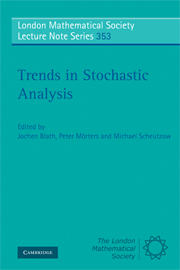Book contents
- Frontmatter
- Contents
- Preface
- Heinrich von Weizsäcker's students
- Heinrich von Weizsäcker's publications
- I Foundations and techniques in stochastic analysis
- 1 Random variables – without basic space
- 2 Chaining techniques and their application to stochastic flows
- 3 Ergodic properties of a class of non-Markovian processes
- 4 Why study multifractal spectra?
- II Construction, simulation, discretization of stochastic processes
- III Stochastic analysis in mathematical physics
- IV Stochastic analysis in mathematical biology
2 - Chaining techniques and their application to stochastic flows
Published online by Cambridge University Press: 05 March 2012
- Frontmatter
- Contents
- Preface
- Heinrich von Weizsäcker's students
- Heinrich von Weizsäcker's publications
- I Foundations and techniques in stochastic analysis
- 1 Random variables – without basic space
- 2 Chaining techniques and their application to stochastic flows
- 3 Ergodic properties of a class of non-Markovian processes
- 4 Why study multifractal spectra?
- II Construction, simulation, discretization of stochastic processes
- III Stochastic analysis in mathematical physics
- IV Stochastic analysis in mathematical biology
Summary
Abstract
We review several competing chaining methods to estimate the supremum, the diameter of the range or the modulus of continuity of a stochastic process in terms of tail bounds of their two-dimensional distributions. Then we show how they can be applied to obtain upper bounds for the growth of bounded sets under the action of a stochastic flow.
Introduction
Upper and lower bounds for the (linear) growth rates of the diameter of the image of a bounded set in Rd under the action of a stochastic flow under various conditions have been shown in [4, 5, 6, 16, 17, 20]. In this survey, we will discuss upper bounds only. A well-established class of methods to obtain probability bounds for the supremum of a process are chaining techniques. Typically they transform bounds for the one-and two-dimensional distributions of the process into upper bounds of the supremum (for a real-valued process) or the diameter of the range of the process (for a process taking values in a metric space). In the next section, we will present some of these techniques, the best-known being Kolmogorov's continuity theorem, which not only states the existence of a continuous modification, but also provides explicit probabilistic upper bounds for the modulus of continuity and the diameter of the range of the process. We will also state a result which we call basic chaining.
Information
- Type
- Chapter
- Information
- Trends in Stochastic Analysis , pp. 35 - 64Publisher: Cambridge University PressPrint publication year: 2009
Accessibility standard: Unknown
Why this information is here
This section outlines the accessibility features of this content - including support for screen readers, full keyboard navigation and high-contrast display options. This may not be relevant for you.Accessibility Information
- 9
- Cited by
